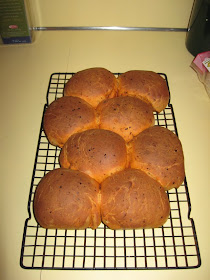My Pizza Doh uses unbleached Wheat bread flour, Quinoa flour, Pine nuts, sea salt, granulated sugar, bread machine yeast, and spring water. I take a cup and a half of spring water, two teaspoons of sugar, two teaspoons of granulated sugar, two teaspoons of bread machine yeast, and mix them in the mixer bowl to start fermenting. In the meantime, I'll clean and grind the Ancho chiles.
I'll take out the stem, and the calyx, which is the crown of the stem which attaches to the membranes which hold the seeds inside the chile. Then tear, or cut the chiles into smaller pieces so they can fit into the spice grinder.
Then grind them into a powder so that the Ancho will mix well with the flour. It took a couple of batches in this small spice grinder. Be careful not to inhale the dust from the spice grinding process through your nose, you will regret it.
So, now that we have the fresh chile powder prepared we can get on with the bread making process. I'll take and ounce and a half of Pine nuts, put them on a sheet pan, and roast them in the oven at 350 degrees Fahrenheit for 10 minute. Then transfer them to a bowl to cool for another 10 minutes. Place the cooled Pine nuts in a food processor and grind into a powder, but not too long otherwise they will turn into Pine nut butter.
The Yeast mixture should be bubbling nicely at this point. This tells you that it is ready to mix into the bread mixture. Whisk about four tablespoons of Olive Oil into the Yeast mixture then add one cup of Quinoa flour, and three and a quarter cups of unbleached bread flour to the mixing bowl. Also add the ground Pine nuts, and the Ancho chile powder. Then secure the mixing bowl onto the mixer, and knead on low speed with a Doh hook for 10 minutes.
My mixer is thoroughly used, so its a bit floppy. I have to secure it to the counter with a clamp otherwise it walks all over the counter, and sometimes off the counter...
I'll weigh the entire Dohball first so I can divide it down into portion sizes. This time it is 2 pounds and 10 ounces, or 42 ounces, and I want to make 8 rolls, so that 6 ounces each. I'll cut and weigh each portion individually, then shape the portions, and place them on a oiled sheet pan to rise.
It will take the Dohballs a few hours to rise before they are ready to bake. They need to proof, and professional bakers use a proofing box to allow the Doh to rise before baking it. The proofing box has a small heater, and a humidifier in it. It keeps the exterior of the Doh moist, while elevating the temperature to level where the Yeast are happy to go to work for us, around 100 degrees Fahrenheit. Well, most home chefs don't have proofing boxes. So, we need to improvise here. I have two ovens, stacked, large one on top and a small one on bottom. The large upper over is the one I usually use for cooking, and the lower over is usually used for proofing. I proof the Doh in the lower oven with the light turned on, but not the heater element. The light is enough heat for the proofing process, and if I need extra humidity I'll add a bowl of hot water under the baking sheet with the Doh.
After a couple of hours the Doh will double, or more, in size. There is a judgement call to be made here. If you like bread that is more dense, proof it less. If you like bread that is light and airy, proof it more. It depends on the size of the bubbles in the Doh, formed by carbon dioxide gas, that is produced by the Yeast in the Doh...
While the Doh is proofing, you can preheat the other oven to the cooking temperature, which for these rolls I am going to set to 425 degrees Fahrenheit. When the Dohballs are proofed to your liking then transfer them from the proofing box to the cooking oven, and bake for 13 to 15 minutes. You have to watch them for doneness, because this is not an exact science. First you don't want to burn the bread, but you do want to cook it to a point where it is Golden, Brown, and Delicious, which is right before, perhaps seconds away from burned. So it takes some skill to know when the bread is cooked properly. The rolls will sound hollow when they are thumped as well.
These rolls were awesome right out of the oven with a little butter. I also tried them sliced in half, then griddled on the inside with some butter and Garlic salt. This week I'll use them for sandwiches, and on the side with some Pinto beans. I usually have bread with soup also, like my Swai Pho. But I think first I'll make a PLT. which is my Pork, Lettuce, and Tomato sandwich with some slow smoked pork butt. Mmmm... Pork Butt...











No comments:
Post a Comment